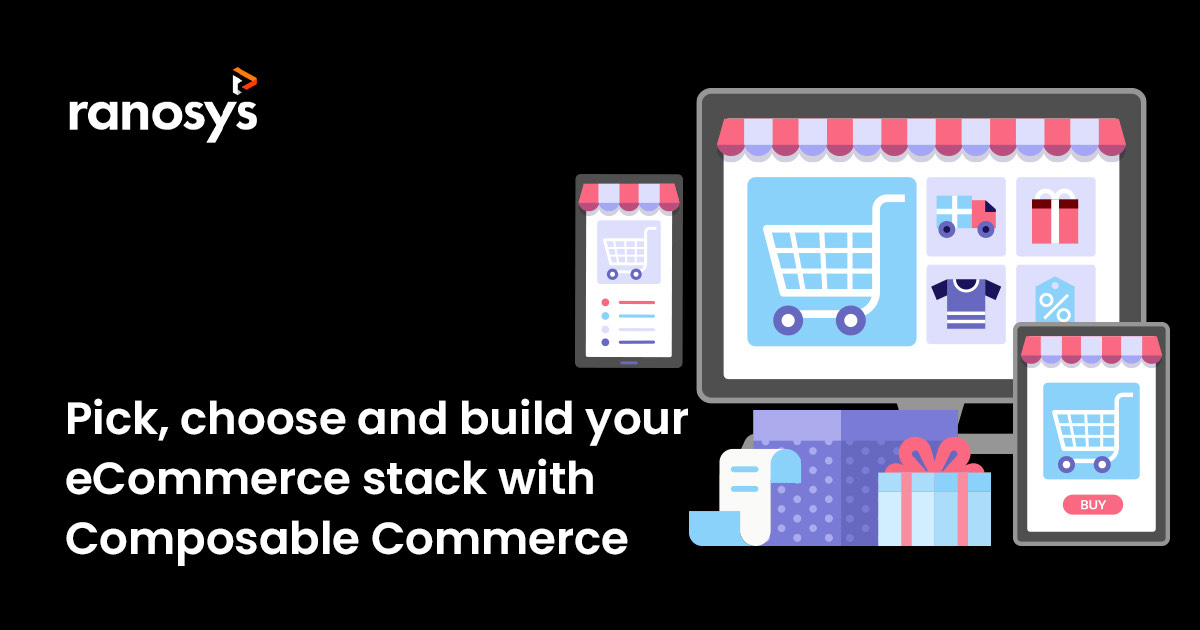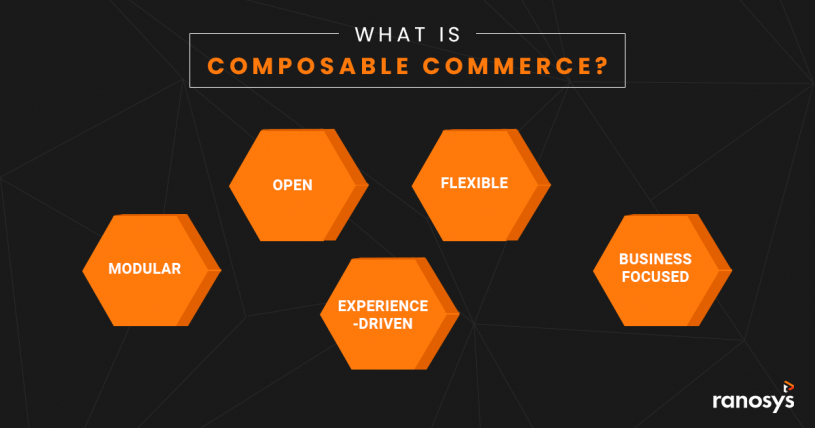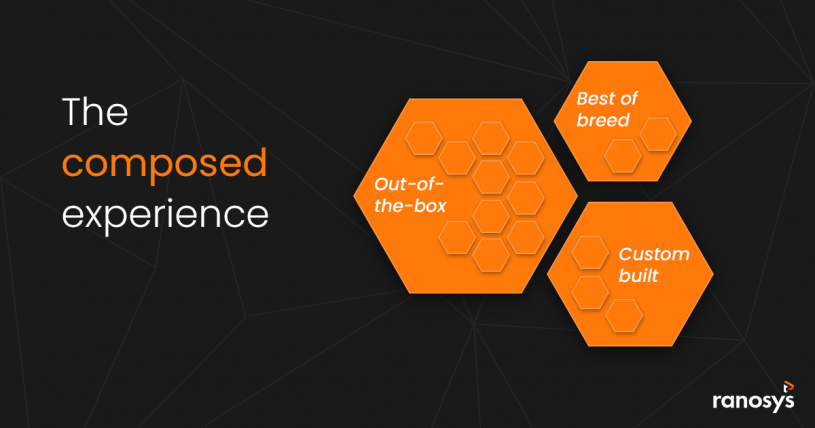Reason#1: Take a step towards digital transformation to ensure future relevance
The new-age of commerce solutions don’t just cater to shoppers on laptops and smartphones, but smart devices like car displays, smart watches, AR/VR headsets, smart home appliances, etc. Retailers cannot offer connected experiences to a whole slew of new devices while being stuck on their legacy eCommerce platforms from the dot-com time that were never created to support all the modern breakpoints.
With composable commerce’s decoupled frontend and backend, you can manage and maintain eCommerce experiences that take all sales channels into consideration. They support your modern customers needs and in case you want to upgrade your eCommerce suite, you can simply deploy a new suitable frontend across the new breakpoint. You can easily shift blocks around, add, change, or modify blocks as per the customer demands and market trends.
Reason #2: Maintain a steady pace with the evolving customer demands
Customers today experience the best of technology there is to offer. It is why their expectations have been raised to an unbelievable level. They want to have a consistent, engaging, and memorable experience across all the touchpoints. They want to be able to browse products across different sales points, track their orders from any device, and update their information from any breakpoint.
Composable commerce allows you to create your unique brand experience from scratch one that quickly and flexibly responds to new customer expectations and is easily integrated to popular third-party systems to offer elevated commerce solutions. Instead of waiting months and weeks to update your eCommerce stores as per the customer requirements, you can do so in days and weeks, which helps you keep pace with your market.
Reason 3: Customized and easily modified digital commerce interfaces
Monoliths, at the time of their inception, were designed to help businesses simply go online. They were not designed to help you customize your commerce solutions to the specifics of your business. Retailers were to rely on a pre-set assortment of components that could fulfill most but not all of their business requirements. Flexibility was a far-fetched idea and scalability was never in the books. But today’s modern era cannot suffice to such limited functionalities.
And this is where composable commerce fits right in. Unlike the restricted monoliths solutions, composable architectures allow you to customize your eCommerce systems to the exact needs of your business. You can tailor it to include all the features you want, modify blocks that don’t work for you anymore, or change the frontend template of any sales touchpoint you want. This experience-driven solution not only allows you to transform faster, but without compromising on either your business’ USP or your consumer numbers.
Reason #4: Better ROIs from your commerce stack
With composable commerce, you can calculate ROIs in three different areas:
- Total cost of ownership (TCO): Unlike monoliths that charge for the full package including even those features that you don’t use or make no sense for your business, composable systems employ the pay-per-use pricing norms. It means you only have to pay for commerce solutions that you use, which you can easily change as per your requirements. It allows businesses to deliver impressive experiences at substantially lower costs.
- Higher revenues: With lower cost-to-market, faster time-to-market, and better flexibility, composable commerce allows businesses to easily modify, add, or scale their commerce system based on the ongoing events, trends or new business models. It includes attributes like GMV (gross market value), conversion rates, and launching stores in new markets or on new channels.
- Reduced maintenance costs: A composable architecture is easy to launch, upgrade, maintain and modify. It means you spend less time solving fixes in deployments and more time on figuring out the right features and functionalities for your store. Moreover, the composable approach allows you to pinpoint the root cause of problems more quickly by testing attributes in isolation, for instance, testing shipping experiences for optimal results. So, instead of testing the entire end-to-end eCommerce solution, you can simply test a specific feature in isolation and fix it within no time.
Is my brand ready to build a composable commerce stack?
As a retailer, all you want is an digital commerce stack that:
- Serves your customers the way they want to be served
- Ensure the future-readiness of your eCommerce infrastructure
- Scales up and down easily as per demands
And it is possible that your eCommerce stack in use right now is able to deliver all these propositions to you. But, when you consider things from a future-driven perspective, everything changes. In the future, you don’t need a one-for-all your needs commerce solutions to pick all those solutions that work for your business and assemble them into one unified commerce suite. If you’re brainstorming whether a composable architecture is the right fit for your business, here are key quantifiers to focus on:
Migration complexity:
When thinking of implementing any new business mode, time-to-market is the key. Forming the right strategy makes all the difference between endless cycles of optimization and quick and effortless migration. Expert advice from companies who partner with companies like commercetools that offer such solutions can help set your business up for success.
Price:
You need to identify the cost-to-market for a full-replatforming of your eCommerce architecture. Although composable commerce isn’t as expensive as your legacy commerce suites, you need to account for the efforts needed and your business’ affordability into consideration. Obviously, the right eCommerce partner like our experts can help you minimize these costs and do all the legwork for you.
Omnichannel or multichannel selling capabilities:
A composable architecture is most profitable for brands that sell on multiple platforms (in-store, mobile, online, social media, upselling via customer support, etc). As a modern brand, you of course target the maximum sales channels you can get your hands on, which is why composable commerce is definitely worth the consideration.
Digital Maturity:
A composable architecture is mostly famous for its easily scalable, highly flexible, deeply customer-centric, and future-driven approach. However, choosing composable commerce means a complete revamp of your digital operations, which is not a light feat. However, composable builds allow you to approach your project in different ways like:
- Tech-by-tech: where you replace individual systems like the CMS or any section of your commerce system
- Rip-and-replace: where you rip apart your old monolithic platform entirely and replace it with composable elements
- Regional or vertical: where you can change a few sections and test these new features in test markets before launching them across your entire system
Composable commerce allows you the flexibility to choose the approach that works best for your business. But, before you implement any such approach, you must consider your team’s capabilities and your business’ plans for the future. You can always approach leading digital commerce companies that have successful partnerships with futuristic platforms.
Composing unique brand experiences scaled for the future
The best part about composable commerce is that you can easily begin with it and scale it to anywhere you want. Or, you can quickly migrate from your existing eCommerce suite to a composable architecture within no time. A composable architecture gives you the freedom to choose the best for your business and invest in only those limited solutions that you know will work for you. And if something doesn’t work, you can simply remove and replace it with a better feature/functionality.
And if you’re not sure whether or not you need a composable build, our trusted experts can help you with this confusion. They have assisted several brands to transition to a composable system, customized to their specific needs and can do the same for you.






